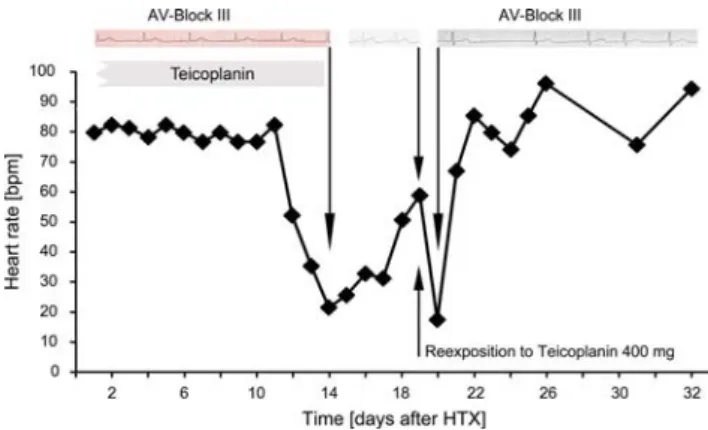Teicoplanin-Induced Complete AV-Block in a Heart
Transplant Recipient
Teicoplanin is a glycopeptide antibiotic used against established or assumed methicillin-resistant gram-positive infections. An association between teicoplanin treatment and advanced heart block has not been reported to date. A 52-year-old man with end-stage heart failure was admitted for implantation of a left ventricular assist device (Berlin Heart INCOR). Two days after implanta-tion the patient received vancomycin (2 · 1 g/day) and rifampicin (4 · 450 mg/day) because of a central venous catheter infection with coagulase-negative Staphylococci. Thirteen days after LVAD device implantation, the patient developed severe pneumonia. Two days later vancomycin was stopped because of drug-induced leuco-penia. Subsequently, vancomycin was then replaced with the glycopeptide teicoplanin at a dose of 600 mg on day 1 and 400 mg QD the following days. The white blood cell count returned to normal in the following days. Five days after begin of teicoplanin therapy orthotopic heart trans-plantation (HTX) was performed. Immunosuppressive therapy was started with anti-T-lymphocyte-immunglob-uline (ATG), cyclosporine, azothioprin and prednisone. Trough plasma levels of teicoplanin were in the range between 13 and 14 mg/l (normal therapeutic range 10–15 mg/l). On day 17 after begin of teicoplanin therapy (day 12 after HTX) the patient developed complete AV-block III (CAVB) (Figure 1). The time interval of 12 days after HTX made a surgical insult during HTX unlikely. Similarly, endomyocardial biopsy (EMB), showed no clinically relevant signs of rejection (ISHT 1A), thus further suggesting potential side effect of drug therapy. Hence, teicoplanin therapy was suspended. Subsequently, sinus rhythm with normal AV conduction (Figure 1) was restored, suggesting that the medication was indeed a likely cause of the AV-block. After inci-dental reexposition to teicoplanin (on day 19 after HTX), the patient developed a rapid decrease in heart rate and CAVB again with hemodynamic instability, which further corroborates this hypothesis. Teicoplanin was stopped, vancomycin started and the sinus rhythm reoccurred again (Figure 1).
Transient or permanent atrioventricular conduction disturbances are well recognized after cardiac surgery. However, only few data on persistent or permanent AV-blockade after heart transplantation are available. In a retrospective study by Cui et al. [1] including 1,047 consecutive patients the overall incidence for AV-block-ade was 10.8%. The incidence of complete AV-block in this study was 1.8% (19 of 1,047 patients). In four patients CAVB occurred immediately after HTX as result of a
surgical insult. In seven patients complete AV-block occurred during EMB or coronary angiography, four episodes of cellular or humoral rejection were associated with CAVB. The time interval of 12 days after HTX makes a surgical insult as a cause of the CAVB unlikely, since the consequences of a surgical insult result in CAVB direct after HTX. EMB performed the day after the occurrence of CAVB showed no clinically significant rejection (ISHT 1A).
Concomitant medications include pipamperon, amphotericin B, captopril, citalopram, calcitriol, predni-sone, cyclosporine, azothioprine, torasemid and valgan-cyclovir, in usual dosages. The combination of the drugs used in the described patient may lead to nephrotoxicity, myelosupression, first-dose hypotension and hypokale-mia. The drugs usually are not reported to cause AV-block and drug–drug interactions between these drugs and teicoplanin are unknown and teicoplanin– plasma levels remained within the normal therapeutic range throughout the course of the treatment. In patients during citalopram therapy, however, sinusbradycardia and second-degree AV-block are described previously [2, 3]. In our patient, citalopram was given during the whole time of the in-hospital-course at the same dose (1 · 20 mg/day). Even after development of CAVB, citalopram was not discontinued.
At usual therapeutic doses teicoplanin is generally well tolerated and severe toxic or allergic reactions are uncommon [4, 5]. Known adverse effects include injection site intolerance (pain, redness, phlebitis), hypersensitivity events (skin reaction, bronchospasm, anaphylactoid reaction), ototoxicity and hematological alterations
Infection 2008; 36: 291–292 DOI 10.1007/s15010-008-7424-5
F. Enseleit (corresponding author), N.J. Mueller, F. Duru, M. Lachat, G. Noll, F. Ruschitzka
CardioVascular Center Cardiology, University Hospital Zurich, 8091 Zurich, Switzerland; Phone: (+41/44) 25-5842, Fax: -859,
e-mail: frank.enseleit@usz.ch N.J. Mueller
Division of Infectious Diseases and Hospital Epidemiology, University Hospital Zurich, 8091 Zurich, Switzerland
M. Lachat
Clinic for Cardiac and Vascular Surgery, University Hospital Zurich, 8091 Zurich, Switzerland
Received: November 5, 2007 Æ Revision accepted: February 21, 2008 Published online: May 12, 2008
Infection
Correspondence(neutropenia, eosinophilia). Nephrotoxicity is also uncommon, even in combination with cyclosporine A. [6] No data exist about heart rhythm disturbances and the use of teicoplanin.
As we here report first evidence of a potentially life-threatening complication, the use of teicoplanin should be exercised with caution, in patients after heart transplantation and concomitant immunosuppressive therapy in particular.
F. Enseleit, N.J. Mueller, F. Duru, M. Lachat, G. Noll, F. Ruschitzka
Acknowledgments
The authors have no conflict of interest.
References
1. Cui G, Kobashigawa J, Margarian A, Sen L: Cause of atrioven-tricular block in patients after heart transplantation. Trans-plantation 2003; 76: 137–142.
2. Favre MP, Sztajzel J, Bertschy G: Bradycardia during citalopram treatment: a case report. Pharmacol Res 1999; 9: 149–150. 3. Gambassi G, Incalzi RA, Gemma A: Atrioventricular blocks
associated with citalopram. Am J Geriatr Psychiatry 2005; 13: 918–919.
4. Davey PG, Williams AH: A review of the safety profile of teicoplanin. J Antimicrob Chemother 1991; 27: 69–73. 5. Finch RG, Eliopoulos GM: Safety and efficacy of glycopeptide
antibiotics. J Antimicrob Chemother 2005; 55: ii5–ii13.
6. Shea KW, Cunha BA: Teicoplanin. Med Clin North Am 1995; 79: 833–844.
Figure 1. Heart rate after orthotopic heart transplantation (HTX). Treatment with teicoplanin began 5 days before HTX and was associated with a complete AV-block and consecutive drop in heart rate starting on day 12 after HTX (17 days after start of teicoplanin therapy). The left ECG strip shows complete AV-block III (CAVB) on day 14 after HTX (19 days after begin of teicoplanin therapy). After stop of teicoplanin sinusrhythm (ECG strip in center) was restored. After incidental reexposition to teicoplanin (on day 19 after HTX), heart rate dropped again due to CAVB (ECG strip on the right).
F. Enseleit et al. Teicoplanin-Induced Complete AV-Block in a Heart Transplant Recipient
